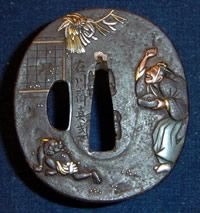 |
Tsuba
(sword guard) with mame-maki scene |
The Japanese traditional calendar divides the solar year into 24 divisions known as setsu. Thus the term setsubun originally referred to the days marking the change from one season to the next, but eventually it came to be applied solely to the last day of the daikan (‘great cold’) setsu, i.e. the day before risshun (‘becoming spring’). The celebration of the New Year originally coincided with risshun, therefore Setsubun became associated with rites of purification, a necessary renewal of self for the coming year and the spring planting season. The modern observance occurs on either 3 or 4 February, depending on the year.
One of the rituals that came to be associated with Setsubun is mame-maki,
a ritual in which beans are thrown in an attempt to banish evil spirits.
In ancient China, at the time of the Zho dynasty (1067-256 BCE), men brandishing
sharp weapons and dressed in bear skins and masks pretended to drive away
demons in a ceremony known as tsuina. By the mid-9th century CE
the rite had made its way to Japan, and was incorporated into the cycle
of annual events observed by the imperial court; from the Muromachi Period
(1333-1568 CE) onwards it came to be enacted on Setsubun.
Families perform mame-maki to drive out evil spirits and the
seeds of misfortune, as well as to pray for the well-being of themselves
and their business. A masu—wooden measuring cup—is
filled with roasted soybeans, which are scattered about the room to shouts
of fuku wa uchi, oni wa soto, “fortune in, demons out.”
Each member of the family then eats a number of beans equivalent to their
age to ensure health and good luck.
At major temples mame-maki is carried out by respected citizens such as priests, actors, and sumo wrestlers, who aim directly at the congregation. Huge crowds are drawn to these events, in the hope that the beans they gather will ensure them prosperity in the coming year.